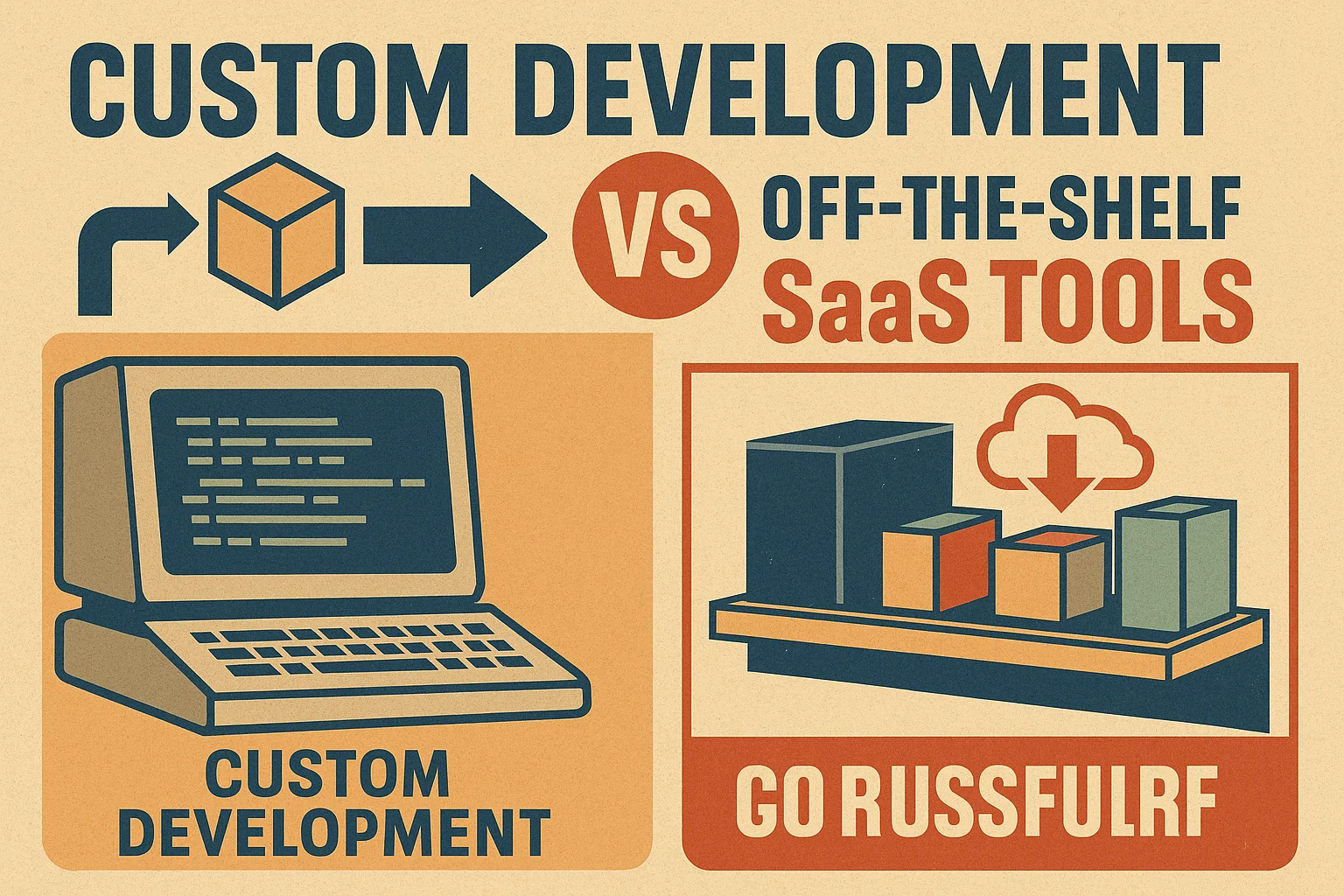- The Eternal Dilemma of SaaS Product Owners
- What Is Custom SaaS Development?
- What Are Off-the-Shelf SaaS Tools?
- When Off-the-Shelf Works
- When Custom SaaS Development Wins (Every Time)
- The Hidden Cost of Off-the-Shelf
- Custom SaaS: The Only Scalable Choice
- SaaS Development Case Study Example
- Final Verdict: What Scales Better?
- Need Help Building It Right?
Custom SaaS Development vs Off-the-Shelf Tools: What Scales Better?

- The Eternal Dilemma of SaaS Product Owners
- What Is Custom SaaS Development?
- What Are Off-the-Shelf SaaS Tools?
- When Off-the-Shelf Works
- When Custom SaaS Development Wins (Every Time)
- The Hidden Cost of Off-the-Shelf
- Custom SaaS: The Only Scalable Choice
- SaaS Development Case Study Example
- Final Verdict: What Scales Better?
- Need Help Building It Right?
The Eternal Dilemma of SaaS Product Owners
So you’ve got a brilliant SaaS product idea, a few MVP wireframes, maybe even a beta user. Now comes the real horror story — “Do I go with custom SaaS development or stitch it together with some no-code Frankenstein?”
Off-the-shelf tools sound great in theory. They're fast, cheap, and promise drag-and-drop unicorn magic. But will they scale?
Custom SaaS development takes longer and costs more. But will it give you an unfair edge long-term?
Short answer: yes.
Long answer: keep reading.
What Is Custom SaaS Development?
Custom SaaS development means designing and building your software product tailored specifically to your needs. It involves:
- Unique business logic
- Custom UX/UI design
- Scalable backend architecture
- Flexible integrations
- Future-proof code
You’re not just making an app. You’re creating a SaaS product architecture that grows with your startup.
What Are Off-the-Shelf SaaS Tools?
Think:
- Shopify
- Airtable
- Bubble
- HubSpot CRM
- Monday.com
- ...or any tool where "customization" means selecting which shade of blue your dashboard will be.
These tools are perfect for launching fast — but not for owning your platform or solving niche business problems.
When Off-the-Shelf Works
Let’s be fair. Off-the-shelf tools do have their moment:
Use them when:
- You’re validating your SaaS idea
- Your budget is micro-sized
- You need to launch in days, not months
- You’re building an internal tool, not a product
Example:
A founder building an MVP with no tech background might use Airtable + Zapier + Webflow to launch a prototype in 48 hours. That’s great... until real users show up, and performance melts faster than cheap ice cream.
When Custom SaaS Development Wins (Every Time)
1. Scalability
With a custom SaaS backend (Node.js, Laravel, or Django), you can:
- Handle 10 or 10,000 users
- Add features without hitting no-code limits
- Scale architecture with Docker, AWS, or GCP
Bonus: You won’t pay $400/month just to unlock API access.
2. Security & Compliance
Need GDPR? HIPAA? SOC2? Off-the-shelf is a gamble.
Custom development gives your legal team peace of mind.
According to TechCrunch, 35% of SaaS startups fail compliance audits due to inflexible vendor tools. Custom infrastructure allows full control over encryption, data handling, and backups.
3. Brand and UX Ownership
Custom UX/UI isn’t just aesthetics — it’s conversion, retention, and user trust. Good luck designing onboarding flows inside someone else’s design sandbox.
A Baymard Institute UX study shows that poorly adapted interfaces decrease user conversion rates by up to 39%. Custom design isn’t a luxury — it’s user survival.
The Hidden Cost of Off-the-Shelf
What no one tells you:
- You don’t own the code
- API access is limited
- You’re locked into a vendor
- Growth means hitting a wall, then rebuilding from scratch
And don’t even get us started on the UX flexibility — it’s like trying to redecorate a hotel room with duct tape and sticky notes.
Custom SaaS: The Only Scalable Choice
Let’s face it. If you’re serious about:
- Raising funding
- Serving thousands of users
- Offering unique features
- Outpacing competitors
You’ll outgrow off-the-shelf tools faster than your CTO can say “we should’ve built this from scratch.”
SaaS Development Case Study Example
One of our healthcare SaaS clients started with Airtable + Integromat. Within 4 months, they hit performance ceilings and couldn’t customize reporting. We rebuilt their backend using Node.js + PostgreSQL + a React frontend.
Result:
- 5x faster response time
- Built-in HIPAA support
- Fully custom patient dashboard
- Ready for scale
Want the same?
Final Verdict: What Scales Better?
| Feature | Off-the-Shelf | Custom SaaS |
|---|---|---|
| Launch Speed | Fast | Slower |
| Scalability | Limited | High |
| Ownership | None | Full |
| Flexibility | Constrained | Infinite |
| Long-Term Cost | Adds Up | Pays Off |
Investing in custom SaaS development today means skipping the inevitable rebuild tomorrow. Startups that scale successfully — think Notion, Figma, or Stripe — all rely on tailored codebases that support fast iteration and deep customization.
Off-the-shelf tools are great… until you need to differentiate. And differentiation is where custom SaaS development shines.
Need Help Building It Right?
Integritas has helped SaaS startups in fintech, healthcare, edtech and beyond build high-performance platforms from scratch.
Visit our Web Development Services.
If you're building a custom SaaS solution, don’t overlook the importance of a well-designed dashboard — it’s where users live. Learn how to design a startup dashboard that actually works.


